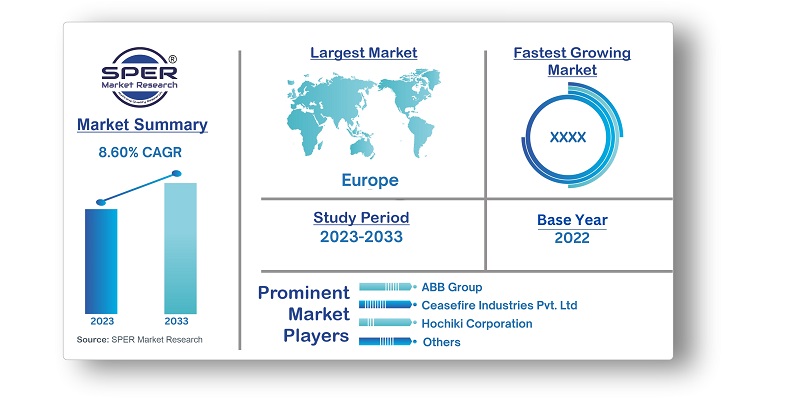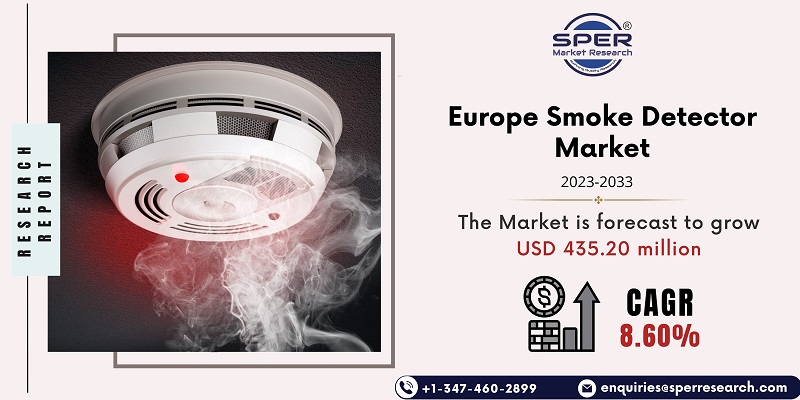
Europe Smoke Detector Market Growth, Size, Trends, Demand, Revenue, Share and Future Outlook
Europe Smoke Detector Market Size– By Product Type, By End User- Regional Outlook, Competitive Strategies and Segment Forecast to 2033
| Published: Jan-2024 | Report ID: IACT2409 | Pages: 1 - 153 | Formats*: |
| Category : Information & Communications Technology | |||
- Siemens declared the release of Cerberus FIT, a new iteration of their fire safety system. In addition to increasing productivity for those tasked with building protection, Cerberus FIT optimizes fire safety. With this launch, the company will increase the range of products it offers to the small- to medium-sized building market, which will aid in its expansion.


| Report Metric | Details |
| Market size available for years | 2019-2033 |
| Base year considered | 2022 |
| Forecast period | 2023-2033 |
| Segments covered | By Product Type, By End User |
| Regions covered | Eastern Region, Western Region, Northern Region, Southern Region |
| Companies Covered | ABB Group, Ceasefire Industries Pvt. Ltd., Google LLC (Alphabet Inc.), Hochiki Corporation, Honeywell International, Inc., Johnson Controls International PLC, Robert Bosch GmbH, Schneider Electric SE, and others. |
- Builders and Developers
- Architects and Designers
- Fire Safety Consultants
- End-Users (Residential, Commercial, Industrial)
| By Product Type: | |
| By End User: | |
| By Region: |
- Europe Smoke Detector Market Size (FY’2023-FY’2033)
- Overview of Europe Smoke Detector Market
- Segmentation of Europe Smoke Detector Market By Product Type (Optical Sensor Smoke Detector, Photoelectric Smoke Detector, Dual Sensor Smoke Detector)
- Segmentation of Europe Smoke Detector Market By End User (Commercial, Manufacturing, Telecommunication, Residential, Oil, Gas & Mining, Others)
- Statistical Snap of Europe Smoke Detector Market
- Expansion Analysis of Europe Smoke Detector Market
- Problems and Obstacles in Europe Smoke Detector Market
- Competitive Landscape in the Europe Smoke Detector Market
- Impact of COVID-19 and Demonetization on Europe Smoke Detector Market
- Details on Current Investment in Europe Smoke Detector Market
- Competitive Analysis of Europe Smoke Detector Market
- Prominent Players in the Europe Smoke Detector Market
- SWOT Analysis of Europe Smoke Detector Market
1.1. Scope of the report1.2. Market segment analysis
2.1. Research data source2.1.1. Secondary Data2.1.2. Primary Data2.1.3. SPER’s internal database2.1.4. Premium insight from KOL’s2.2. Market size estimation2.2.1. Top-down and Bottom-up approach2.3. Data triangulation
4.1. Driver, Restraint, Opportunity and Challenges analysis4.1.1. Drivers4.1.2. Restraints4.1.3. Opportunities4.1.4. Challenges4.2. COVID-19 Impacts of the Europe Smoke Detector Market
5.1. SWOT Analysis5.1.1. Strengths5.1.2. Weaknesses5.1.3. Opportunities5.1.4. Threats5.2. PESTEL Analysis5.2.1. Political Landscape5.2.2. Economic Landscape5.2.3. Social Landscape5.2.4. Technological Landscape5.2.5. Environmental Landscape5.2.6. Legal Landscape5.3. PORTER’s Five Forces5.3.1. Bargaining power of suppliers5.3.2. Bargaining power of buyers5.3.3. Threat of Substitute5.3.4. Threat of new entrant5.3.5. Competitive rivalry5.4. Heat Map Analysis
6.1. Europe Smoke Detector Market Manufacturing Base Distribution, Sales Area, Product Type6.2. Mergers & Acquisitions, Partnerships, Product Launch, and Collaboration in Europe Smoke Detector Market
7.1. Europe Smoke Detector Market Value Share and Forecast, By Product Type, 2023-20337.2. Optical Sensor Smoke Detector7.3. Photoelectric Smoke Detector7.4. Dual Sensor Smoke Detector
8.1. Europe Smoke Detector Market Value Share and Forecast, By End User, 2023-20338.2. Commercial8.3. Manufacturing8.4. Telecommunication8.5. Residential8.6. Oil, Gas & Mining8.7. Others
9.1. Europe Smoke Detector Market Size and Market Share
10.1. Europe Smoke Detector Market Size and Market Share By Product Type (2019-2026)10.2. Europe Smoke Detector Market Size and Market Share By Product Type (2027-2033)
11.1. Europe Smoke Detector Market Size and Market Share By End User (2019-2026)11.2. Europe Smoke Detector Market Size and Market Share By End User (2027-2033)
12.1. Europe Smoke Detector Market Size and Market Share By Region (2019-2026)12.2. Europe Smoke Detector Market Size and Market Share By Region (2027-2033)12.2.1. Eastern Region12.2.2. Western Region12.2.3. Southern Region12.2.4. Northern Region
13.1. ABB Group13.1.1. Company details13.1.2. Financial outlook13.1.3. Product summary13.1.4. Recent developments13.2. Ceasefire Industries Pvt. Ltd.13.2.1. Company details13.2.2. Financial outlook13.2.3. Product summary13.2.4. Recent developments13.3. Google LLC (Alphabet Inc.)13.3.1. Company details13.3.2. Financial outlook13.3.3. Product summary13.3.4. Recent developments13.4. Hochiki Corporation13.4.1. Company details13.4.2. Financial outlook13.4.3. Product summary13.4.4. Recent developments13.5. Honeywell International, Inc.13.5.1. Company details13.5.2. Financial outlook13.5.3. Product summary13.5.4. Recent developments13.6. Johnson Controls International PLC13.6.1. Company details13.6.2. Financial outlook13.6.3. Product summary13.6.4. Recent developments13.7. Robert Bosch GmbH13.7.1. Company details13.7.2. Financial outlook13.7.3. Product summary13.7.4. Recent developments13.8. Schneider Electric SE13.8.1. Company details13.8.2. Financial outlook13.8.3. Product summary13.8.4. Recent developments13.9 Others
SPER Market Research’s methodology uses great emphasis on primary research to ensure that the market intelligence insights are up to date, reliable and accurate. Primary interviews are done with players involved in each phase of a supply chain to analyze the market forecasting. The secondary research method is used to help you fully understand how the future markets and the spending patterns look likes.
The report is based on in-depth qualitative and quantitative analysis of the Product Market. The quantitative analysis involves the application of various projection and sampling techniques. The qualitative analysis involves primary interviews, surveys, and vendor briefings. The data gathered as a result of these processes are validated through experts opinion. Our research methodology entails an ideal mixture of primary and secondary initiatives.



Frequently Asked Questions About This Report
PLACE AN ORDER
Year End Discount
Sample Report
Pre-Purchase Inquiry
NEED CUSTOMIZATION?
Request CustomizationCALL OR EMAIL US
100% Secure Payment






Related Reports
Our Global Clients
Our data-driven insights have influenced the strategy of 200+ reputed companies across the globe.




















